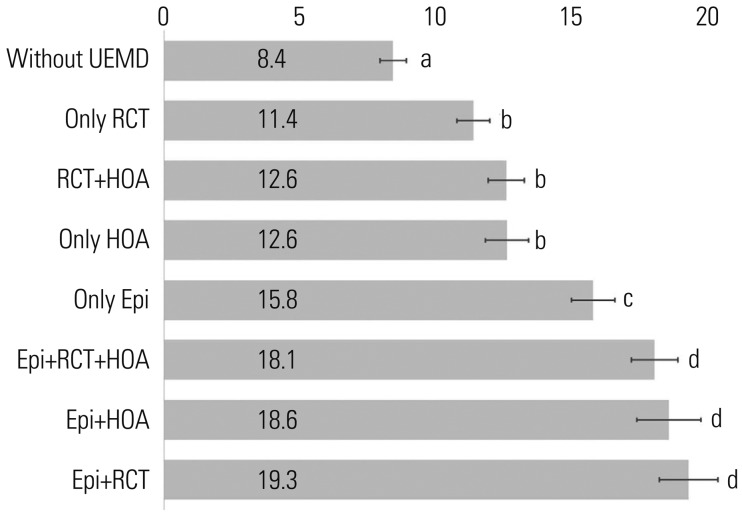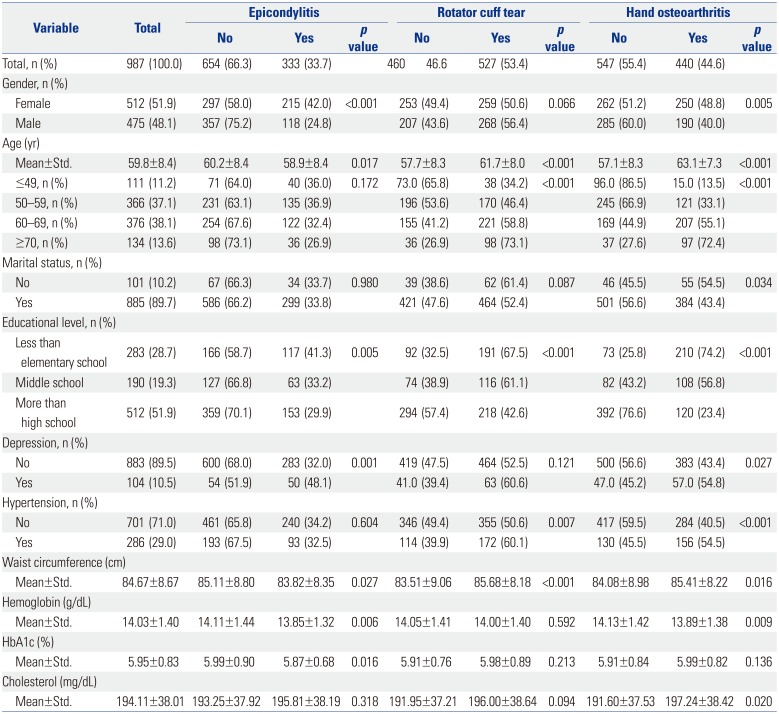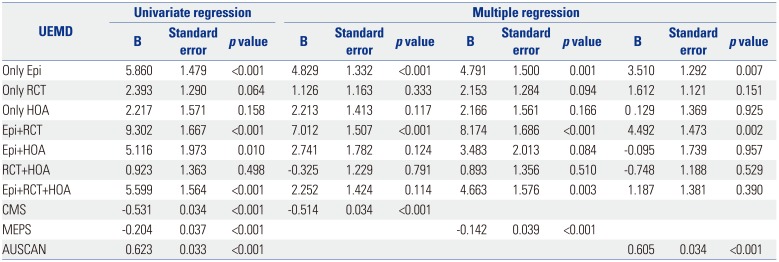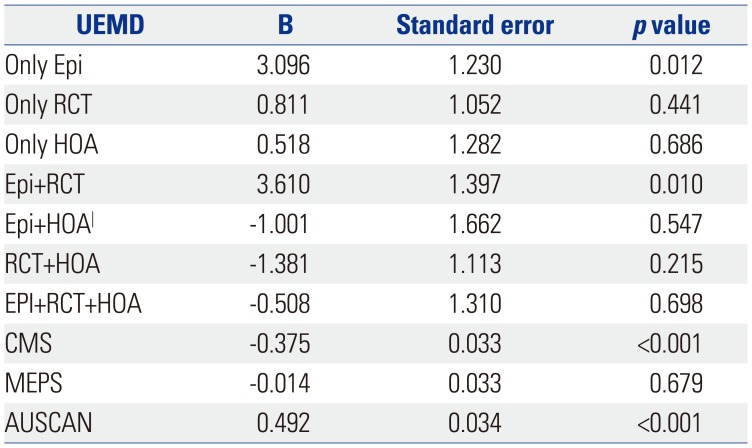1. Huisstede BM, Bierma-Zeinstra SM, Koes BW, Verhaar JA. Incidence and prevalence of upper-extremity musculoskeletal disorders. A systematic appraisal of the literature. BMC Musculoskelet Disord. 2006; 7:7. PMID:
16448572.

2. Huisstede BM, Wijnhoven HA, Bierma-Zeinstra SM, Koes BW, Verhaar JA, Picavet S. Prevalence and characteristics of complaints of the arm, neck, and/or shoulder (CANS) in the open population. Clin J Pain. 2008; 24:253–259. PMID:
18287832.

3. Walker-Bone K, Palmer KT, Reading I, Coggon D, Cooper C. Prevalence and impact of musculoskeletal disorders of the upper limb in the general population. Arthritis Rheum. 2004; 51:642–651. PMID:
15334439.

4. McDonald M, DiBonaventura Md, Ullman S. Musculoskeletal pain in the workforce: the effects of back, arthritis, and fibromyalgia pain on quality of life and work productivity. J Occup Environ Med. 2011; 53:765–770. PMID:
21685799.
5. Spreeuwers D, de Boer AG, Verbeek JH, van Beurden MM, de Wilde NS, Braam I, et al. Work-related upper extremity disorders: one-year follow-up in an occupational diseases registry. Int Arch Occup Environ Health. 2011; 84:789–796. PMID:
21274724.

6. Boocock MG, Collier JM, McNair PJ, Simmonds M, Larmer PJ, Armstrong B. A framework for the classification and diagnosis of work-related upper extremity conditions: systematic review. Semin Arthritis Rheum. 2009; 38:296–311. PMID:
18280546.

7. da Costa JT, Baptista JS, Vaz M. Incidence and prevalence of upper-limb work related musculoskeletal disorders: a systematic review. Work. 2015; 51:635–644. PMID:
26409936.

8. Razmjou H, Bean A, van Osnabrugge V, MacDermid JC, Holtby R. Cross-sectional and longitudinal construct validity of two rotator cuff disease-specific outcome measures. BMC Musculoskelet Disord. 2006; 7:26. PMID:
16533405.

9. Roquelaure Y, Ha C, Leclerc A, Touranchet A, Sauteron M, Melchior M, et al. Epidemiologic surveillance of upper-extremity musculoskeletal disorders in the working population. Arthritis Rheum. 2006; 55:765–778. PMID:
17013824.

10. Slatkowsky-Christensen B, Mowinckel P, Loge JH, Kvien TK. Health-related quality of life in women with symptomatic hand osteoarthritis: a comparison with rheumatoid arthritis patients, healthy controls, and normative data. Arthritis Rheum. 2007; 57:1404–1409. PMID:
18050180.

11. Hegmann KT, Thiese MS, Wood EM, Garg A, Kapellusch JM, Foster J, et al. Impacts of differences in epidemiological case definitions on prevalence for upper-extremity musculoskeletal disorders. Hum Factors. 2014; 56:191–202. PMID:
24669553.

12. Chobanian AV, Bakris GL, Black HR, Cushman WC, Green LA, Izzo JL Jr, et al. The Seventh Report of the Joint National Committee on prevention, detection, evaluation, and treatment of high blood pressure: the JNC 7 report. JAMA. 2003; 289:2560–2572. PMID:
12748199.

13. Marathe PH, Gao HX, Close KL. American Diabetes Association Standards of Medical Care in Diabetes 2017. J Diabetes. 2017; 9:320–324. PMID:
28070960.

14. Lee SY, Park HS, Kim DJ, Han JH, Kim SM, Cho GJ, et al. Appropriate waist circumference cutoff points for central obesity in Korean adults. Diabetes Res Clin Pract. 2007; 75:72–80. PMID:
16735075.

15. Kroenke K, Spitzer RL, Williams JB. The Patient Health Questionnaire-2: validity of a two-item depression screener. Med Care. 2003; 41:1284–1292. PMID:
14583691.
16. Bellamy N, Campbell J, Haraoui B, Buchbinder R, Hobby K, Roth JH, et al. Dimensionality and clinical importance of pain and disability in hand osteoarthritis: Development of the Australian/Canadian (AUSCAN) Osteoarthritis Hand Index. Osteoarthritis Cartilage. 2002; 10:855–862. PMID:
12435330.

17. Constant CR, Murley AH. A clinical method of functional assessment of the shoulder. Clin Orthop Relat Res. 1987; 214:160–164.

18. Morrey BF. The elbow and its disorders. 2nd ed. Philadelphia: Saunders;1993.
19. Hudak PL, Amadio PC, Bombardier C. Development of an upper extremity outcome measure: the DASH (disabilities of the arm, shoulder and hand) [corrected]. The Upper Extremity Collaborative Group (UECG). Am J Ind Med. 1996; 29:602–608. PMID:
8773720.
20. Reinus WR, Shady KL, Mirowitz SA, Totty WG. MR diagnosis of rotator cuff tears of the shoulder: value of using T2-weighted fatsaturated images. AJR Am J Roentgenol. 1995; 164:1451–1455. PMID:
7754891.

21. Sluiter JK, Rest KM, Frings-Dresen MH. Criteria document for evaluating the work-relatedness of upper-extremity musculoskeletal disorders. Scand J Work Environ Health. 2001; 27(Suppl 1):1–102.
22. Kellgren JH, Lawrence JS. Radiological assessment of osteo-arthrosis. Ann Rheum Dis. 1957; 16:494–502. PMID:
13498604.

23. Haugen IK, Englund M, Aliabadi P, Niu J, Clancy M, Kvien TK, et al. Prevalence, incidence and progression of hand osteoarthritis in the general population: the Framingham Osteoarthritis Study. Ann Rheum Dis. 2011; 70:1581–1586. PMID:
21622766.

24. Franchignoni F, Vercelli S, Giordano A, Sartorio F, Bravini E, Ferriero G. Minimal clinically important difference of the disabilities of the arm, shoulder and hand outcome measure (DASH) and its shortened version (QuickDASH). J Orthop Sports Phys Ther. 2014; 44:30–39. PMID:
24175606.

25. Sorensen AA, Howard D, Tan WH, Ketchersid J, Calfee RP. Minimal clinically important differences of 3 patient-rated outcomes instruments. J Hand Surg Am. 2013; 38:641–649. PMID:
23481405.

26. Constant CR, Gerber C, Emery RJ, Søjbjerg JO, Gohlke F, Boileau P. A review of the Constant score: modifications and guidelines for its use. J Shoulder Elbow Surg. 2008; 17:355–361. PMID:
18218327.

27. Hochberg MC, Vignon E, Maheu E. Session 2: clinical aspects. Clinical assessment of hand OA. Osteoarthritis Cartilage. 2000; 8(Suppl A):S38–S40. PMID:
11156493.

28. Lawrence JS, Bremner JM, Bier F. Osteo-arthrosis. Prevalence in the population and relationship between symptoms and x-ray changes. Ann Rheum Dis. 1966; 25:1–24. PMID:
5905334.
29. Minagawa H, Yamamoto N, Abe H, Fukuda M, Seki N, Kikuchi K, et al. Prevalence of symptomatic and asymptomatic rotator cuff tears in the general population: from mass-screening in one village. J Orthop. 2013; 10:8–12. PMID:
24403741.

30. Andrianakos AA, Kontelis LK, Karamitsos DG, Aslanidis SI, Georgountzos AI, Kaziolas GO, et al. Prevalence of symptomatic knee, hand, and hip osteoarthritis in Greece. The ESORDIG study. J Rheumatol. 2006; 33:2507–2513. PMID:
17143985.
31. Gumina S, Carbone S, Campagna V, Candela V, Sacchetti FM, Giannicola G. The impact of aging on rotator cuff tear size. Musculoskelet Surg. 2013; 97(Suppl 1):69–72. PMID:
23588834.

32. Kloppenburg M, Kwok WY. Hand osteoarthritis--a heterogeneous disorder. Nat Rev Rheumatol. 2011; 8:22–31. PMID:
22105244.

33. Parsons IM, Apreleva M, Fu FH, Woo SL. The effect of rotator cuff tears on reaction forces at the glenohumeral joint. J Orthop Res. 2002; 20:439–446. PMID:
12038616.

34. Descatha A, Albo F, Leclerc A, Carton M, Godeau D, Roquelaure Y, et al. Lateral epicondylitis and physical exposure at work? A review of prospective studies and meta-analysis. Arthritis Care Res (Hoboken). 2016; 68:1681–1687. PMID:
26946473.

35. Mora DC, Miles CM, Chen H, Quandt SA, Summers P, Arcury TA. Prevalence of musculoskeletal disorders among immigrant Latino farmworkers and non-farmworkers in North Carolina. Arch Environ Occup Health. 2016; 71:136–143. PMID:
25454715.

36. Pullopdissakul S, Ekpanyaskul C, Taptagaporn S, Bundhukul A, Thepchatri A. Upper extremities musculoskeletal disorders: prevalence and associated ergonomic factors in an electronic assembly factory. Int J Occup Med Environ Health. 2013; 26:751–761. PMID:
24264438.

37. Jeong J, Shin DC, Kim TH, Kim K. Prevalence of asymptomatic rotator cuff tear and their related factors in the Korean population. J Shoulder Elbow Surg. 2017; 26:30–35. PMID:
27497789.

38. Zhang Y, Xu L, Nevitt MC, Niu J, Goggins JP, Aliabadi P, et al. Lower prevalence of hand osteoarthritis among Chinese subjects in Beijing compared with white subjects in the United States: the Beijing Osteoarthritis Study. Arthritis Rheum. 2003; 48:1034–1040. PMID:
12687546.

39. Dahaghin S, Bierma-Zeinstra SM, Hazes JM, Koes BW. Clinical burden of radiographic hand osteoarthritis: a systematic appraisal. Arthritis Rheum. 2006; 55:636–647. PMID:
16874787.











 PDF
PDF ePub
ePub Citation
Citation Print
Print



 XML Download
XML Download